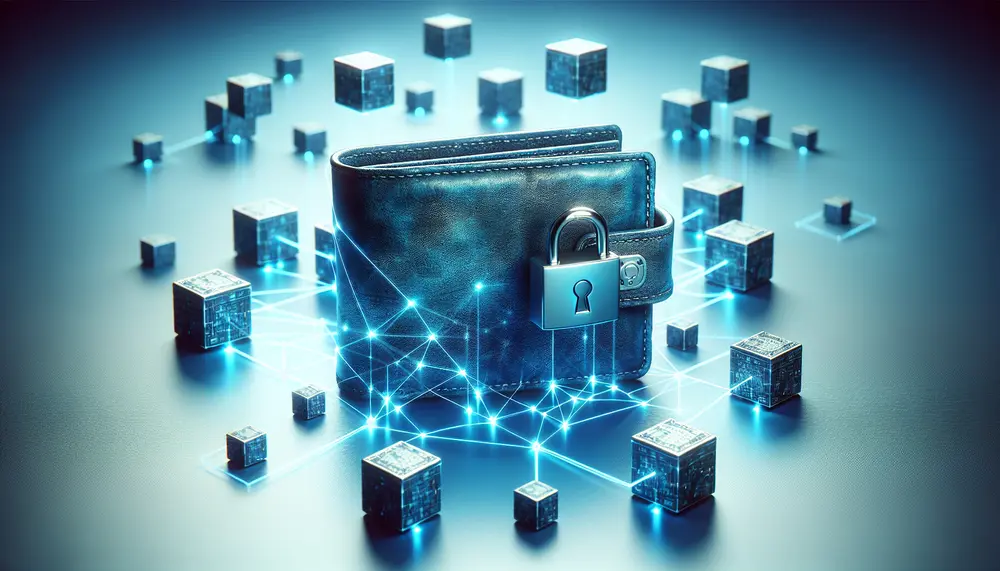Table of Contents:
Understanding Crypto Wallet Verification
In the realm of digital assets, understanding crypto wallet verification is a fundamental step in safeguarding your investments. Verification is a security measure that ensures the person accessing the crypto wallet is the legitimate owner. This process prevents unauthorized access and potential theft of your assets. It's not just about keeping your digital currency from falling into the wrong hands; it's also about establishing trust in a system that relies heavily on anonymity and lacks central oversight.
Crypto wallet verification can involve several layers of security, ranging from simple password protection to multi-factor authentication methods. It often includes verifying your identity through various means to ensure that you, and only you, have control over your digital fortunes. At its core, this process is designed to connect a specific individual with a particular wallet, creating an accountable link that is essential for maintaining the integrity of transactions.
The Best Mining Providers at a Glance
» Infinity HashFrom our perspective, currently the best mining provider on the market. With the community concept, you participate in a mining pool completely managed by professionals. A portion of the earnings are used for expansion and maintenance. We've never seen this solved as cleanly anywhere else.
» Hashing24A well-known and established cloud hosting company. With a good entry point and in a good market phase, a good ROI can also be generated with some patience. Unfortunately, we see the durations as a major drawback.
Engaging in thorough wallet verification not only secures your crypto assets but also contributes to the wider effort of preventing fraud and financial crime in the blockchain ecosystem. As cryptocurrency continues to gain mainstream acceptance, the importance of robust wallet verification methods will only increase, making understanding this process all the more crucial for participants in the market.
The Importance of Verifying Your Crypto Wallet
Verifying your crypto wallet is a critical step in establishing ownership and maintaining the security of your digital assets. This layer of protection is essential in a decentralized financial environment, where traditional safety nets might not be present. The verification of your wallet adds a necessary barrier against unauthorized transactions, helping to ensure that your crypto holdings remain under your control.
A verified wallet also aids in the recovery of access should you forget your credentials or lose access to your device. Many crypto platforms require wallet verification to provide assistance in recovering your account. It is a form of identity confirmation that allows service providers to confirm that they are indeed helping the rightful owner, and not someone with malicious intent.
Furthermore, participating in the broader cryptocurrency network with a verified wallet boosts the overall trustworthiness of the system. It signifies to other users and investors that you are a verified participant, which can be beneficial in transactions and collaborations within the crypto community. A verified status can act as a signal of reliability in peer-to-peer transactions and within decentralized finance (DeFi) platforms.
Lastly, some regulatory and compliance requirements mandate the verification of wallets for anti-money laundering (AML) and combating the financing of terrorism (CFT). These regulations are designed to prevent illegal activities and maintain the legitimacy of digital asset transactions. By verifying your wallet, you not only comply with these regulations but also contribute to a safer and more trustworthy digital asset marketplace.
Assessing the Pros and Cons of Crypto Wallet Verification
| Pros | Cons |
|---|---|
| Enhanced security against unauthorized access | Can be inconvenient requiring multiple steps for access |
| Reduces the risk of theft by hackers | Recovery of assets can be difficult if verification data is lost |
| Provides a trustworthy process for transactions | May involve sharing personal information, raising privacy concerns |
| Gives users control over their digital assets | Technical challenges for new users |
| Possibility of implementing insurance policies against theft | Complexity can lead to user errors and loss of funds |
Types of Crypto Wallets and Their Security Features
Crypto wallets vary in type and each comes equipped with distinct security features tailored to different levels of user engagement and security needs. Broadly, wallets fall into two categories: hot wallets and cold wallets.
Hot wallets are connected to the internet, providing ease of access and convenience for frequent transactions. Security features for these include:
- Two-factor authentication (2FA), requiring a second piece of information before access is granted.
- Email or SMS confirmations for withdrawals to verify that the transaction is initiated by the owner.
- IP and device whitelisting that restricts wallet access to known devices.
- Multi-signature capabilities necessitating more than one private key to authorize a transaction.
On the other hand, cold wallets are offline storage options considered more secure due to their detachment from the internet. Their security features often include:
- Hierarchical Deterministic (HD) structure that generates a new address for every transaction, enhancing privacy.
- Hardware-based protection storing private keys on a physical device such as USB drives or specially designed hardware wallets.
- Paper wallets which are essentially QR codes printed on paper, representing your private and public keys.
Each type of wallet carries unique attributes for maintaining security and ensuring the safekeeping of digital assets. Users must weigh convenience against risk, choosing more secure wallet types for holding large sums and using less secure, but more convenient, types for everyday transactions.
Step-by-Step Guide to Crypto Wallet Verification
Verifying a crypto wallet is a crucial process that may differ slightly depending on the type of wallet and the provider. However, a general step-by-step guide can ensure a standard level of security across all platforms.
- Choose a reputable wallet provider: Begin by selecting a trusted provider that offers strong security measures and fits your needs.
- Create your wallet: Follow the prompts to create a new wallet. This will involve setting up a username, a strong password, and, in many cases, a recovery phrase.
- Secure your recovery phrase: Write down your recovery phrase and store it in a safe place. This phrase is critical for account recovery if you lose access to your device.
- Enable additional security features: Set up 2FA, email confirmations, and any other available security features offered by your wallet provider.
- Identity verification: Provide the necessary identification documents or personal information required by your wallet provider to verify your identity.
- Confirm your email and phone number: Verify your contact details through confirmation links or codes sent to your provided email address or phone number.
- Link to a funding source: Add a bank account or credit card to fund your wallet, if applicable. This may require additional verification to ensure secure linkage.
- Perform a test transaction: Send a small amount of cryptocurrency to another wallet to ensure your setup is correct and secure.
Completing these steps will give you confidence that your crypto wallet is verified and secure. Always remember to regularly review and update your security settings to guard against new threats.
Common Verification Methods for Crypto Wallets
As part of maintaining a secure blockchain ecosystem, crypto wallets implement a variety of verification methods to ensure that users are indeed the owners of their respective wallets. While the methods may vary in complexity, they play a crucial role in enhancing the security of digital assets.
- Email Verification: One of the simplest and most common methods, where a link or code is sent to the user's registered email address to verify ownership.
- Phone Number Verification: Similar to email, a code sent via SMS to the user's mobile device which must be entered to confirm the wallet's linkage to the user.
- Biometric Verification: Utilizing unique user features such as fingerprints or facial recognition to access the wallet, adding a personal layer of security.
- Photo ID Verification: Uploading a government-issued ID to validate the user's identity with the wallet provider for added account security.
- Physical Mailing Address: Providing a physical address which may be used to send a verification code or document, confirming the user's physical world connection to their wallet.
- Security Questions: Answering personally crafted questions that are known only to the user as an additional proof of identity.
These methods, either used individually or collectively, form a comprehensive approach to securing access to crypto wallets. They can be tailored to the level of security required by the user, balancing convenience with the imperative need to protect digital assets.
Protecting Your Private Keys: Best Practices
Private keys are the cornerstone of crypto wallet security, granting the owner access to their currencies. Protecting these keys is paramount to avoid unauthorized access and potential loss. Below are best practices for keeping private keys secure:
- Keep it offline: Store your private keys in a cold storage solution, like a hardware wallet or a paper wallet, away from online vulnerabilities.
- Use secure storage solutions: Employ hardware wallets or safety deposit boxes for physical copies of your private keys.
- Avoid sharing: Never disclose your private keys to anyone. Sharing these puts your assets at risk of theft or misuse.
- Backup your keys: Make multiple backups of your private keys and store them in different secure locations to prevent loss due to physical damage or theft.
- Encrypt your keys: Use strong encryption before storing your keys digitally, to protect them in case your system is compromised.
- Regularly update security: Regular security reviews and updates can mitigate risks associated with evolving threats.
By following these practices, you can significantly reduce the risk of losing access to your crypto assets and ensure your investments remain safe.
The Role of Two-Factor Authentication in Wallet Security
Two-factor authentication (2FA) serves as a critical layer of defense in bolstering the security of crypto wallets. It operates by amalgamating something the user knows, like a password, with something the user possesses, such as a mobile phone, which receives a unique code. This dual-layer security ensures that even if one factor, like a password, is compromised, unauthorized users still cannot gain access without the second factor.
- SMS-Based 2FA: A text message with a code is sent to the user's phone that needs to be entered within a short time frame.
- App-Based 2FA: Services like Google Authenticator or Authy generate time-sensitive codes that users must enter to access their wallets.
- Hardware-Based 2FA: Devices like YubiKey, which the user plugs into their computer, providing a physical key that complements the digital authentication process.
With 2FA active, even if a user's primary password is exposed, the requirement of a second, ephemeral code presents a formidable obstacle for malicious actors. It is an accessible and robust method to significantly diminish the risk of funds being accessed unlawfully.
Dealing with Compromised Wallets: Recovery Steps
In the unfortunate event that a crypto wallet is compromised, taking swift and decisive action is imperative to mitigate potential losses and recover account control. Here are the recommended steps to address such a situation:
- Change Passwords: Immediately update your wallet's password, as well as the passwords of associated accounts, such as your email.
- Transfer Assets: If possible, move your funds to a new wallet with a different private key to protect them from unauthorized transactions.
- Contact Support: Get in touch with the wallet provider's customer support for guidance and to inform them of the breach.
- Check for Malware: Run a comprehensive security check on your devices to ensure they are free from any malicious software.
- Enable Enhanced Security Measures: Activate additional security features such as 2FA, multi-signature protocols, or biometric verification if not already in use.
- Review Transaction History: Scrutinize your wallet's transaction history to identify any unauthorized activity and inform relevant authorities if needed.
- Inform Others: Alert the community or network about compromised addresses to prevent others from sending funds to these potentially unsafe locations.
While dealing with a compromised wallet can be stressful, following these structured steps can provide a path towards securing your assets and restoring security to your digital wallet.
Future of Crypto Wallet Security: Innovations and Trends
The ongoing evolution of cryptocurrency technology heralds a future for wallet security that is both exciting and complex. Innovations in the pipeline aim at fortifying wallet security while sustaining user-friendly accessibility.
- Decentralized Identity Verification: Emerging solutions intend to give users control over their identity data, employing blockchain technology for secure, verifiable digital identities without centralized vulnerability points.
- Smart Contracts for Security: Smart contracts can potentially automate certain aspects of security, such as locking down funds in response to suspicious activity or enforcing multi-signature authentication process parameters.
- Biometric Security Enhancements: Advanced biometric verification, including retina or vein pattern recognition, is being explored to add another layer of security that is unique to each user.
- Quantum-Resistant Cryptography: With the advent of quantum computing, the development of cryptography algorithms that can withstand quantum attacks is critical to future-proofing wallet security.
As cryptocurrency adoption extends, the need for innovative security measures will increase in parallel. The community can anticipate a multi-faceted approach to wallet security, combining time-tested and avant-garde methods to ensure asset protection in an ever-evolving digital landscape.
Conclusion: The Value of Diligent Crypto Wallet Verification
The meticulous verification of crypto wallets is an indispensable practice for anyone venturing into the realm of digital assets. It serves as the first line of defense in a space where security breaches can have immediate and substantial repercussions. Verification processes empower users to take control of their asset security, contribute to the integrity of the broader crypto ecosystem, and comply with evolving regulatory requirements.
Diligent verification underpins the trust and efficiency of crypto transactions and helps in warding off unauthorized access and fraud. The future developments in wallet security promise even more robust solutions, making the crypto space safer and more accessible for all participants. It is an investment in peace of mind, knowing that one's digital assets are shielded by layers of thoughtfully implemented security measures.
As the digital currency landscape continues to mature, the responsibility lies with each user to remain vigilant and stay informed about best practices for wallet security. By doing so, they not only protect their investments but also contribute to the ongoing fortification of the cryptocurrency space as a whole.
FAQ: Securing Your Crypto Wallet
Why is crypto wallet verification important?
Crypto wallet verification is crucial as it provides a layer of security that ensures only the rightful owner has access to the wallet's assets. It helps prevent unauthorized access, adds a barrier against theft, and assists in the recovery of the account if access credentials are lost.
What types of crypto wallets are available?
Crypto wallets come in two main types: hot wallets, which are connected to the internet and convenient for frequent transactions, and cold wallets, which are offline and provide enhanced security for storing digital assets over the long term.
What are the common methods for verifying a crypto wallet?
Common crypto wallet verification methods include email verification, phone number verification, biometric verification, photo ID verification, physical mailing address confirmation, and the use of security questions.
How can I protect my private keys?
To protect your private keys, store them offline in a cold storage solution, use secure and encrypted methods for digital storage, avoid sharing your keys with anyone, back them up in multiple secure locations, and regularly update your security practices.
What should I do if my crypto wallet is compromised?
If your crypto wallet is compromised, immediately change all related passwords, move your funds to a new wallet, contact customer support, run a security check for malware, enhance security measures, and review transaction history for any unauthorized activity.








